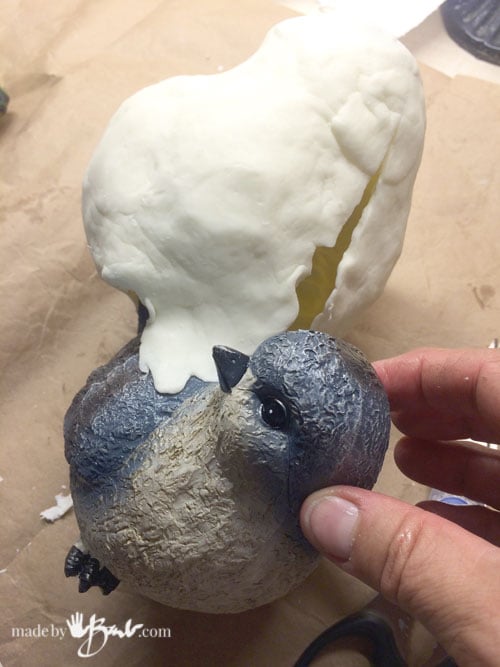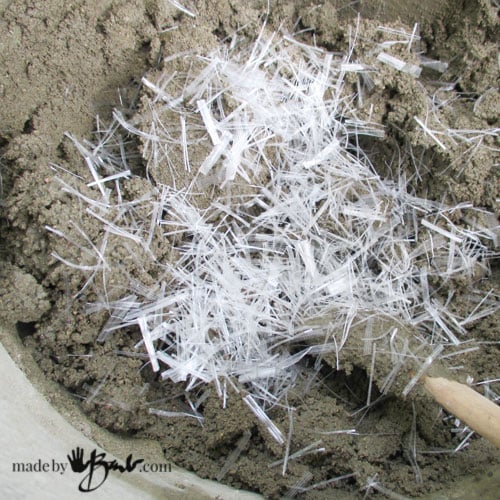Cast your own Concrete Critter Part 2
Now that you have made your mold as shown here from Part 1, you are now ready to Cast your own Concrete Critter. Don’t worry, this is the easy part…
You now have made a mold with some seams that open for removal. Congrats on the hard work! If you are a bit scared of working with concrete you may want to check out this post on ‘Tips & Tricks’.
The Concrete Mix:
Again, as in my other concrete projects (here) I have used my favourite premix; Quikrete Sand Topping Mix. Cheap and strong stuff. It is a pretty basic concrete mix that does NOT have large aggregate (big rocks) in it, only sand and portland cement.
Update: If you want to work faster; I have found a mix that is unmoldable in 1 hour! RapidSet CementAll. It has worked quite well with my other ‘Bunny’ casting project.
Add some Quikcrete mix to your bucket and slowly add water a little at a time making sure to stir to the bottom. (Do wear a good dust mask rated for concrete work.)
To give it extra strength I have added some fibres. You can get them at any building supply place as well. If you are resourceful you could probably make some by cutting up yarn or string into pieces. They disperse themselves and help keep the concrete from cracking. The parts that tend to break are the thin ones like beaks or feet.
Your mold will need to sit level. I have filled a container with sand to cradle the head and keep it stable. Prop yours up with whatever you have, rags will also work well. Secure the mold together with elastics/string. I have also discovered that this material will allow pins to push through to line up the edges.
The Pour:
You have 2 options for pouring. If you use only the Quikrete mix you will probably have a more rustic pour with some bubbles on the surface. If you take extra care to vibrate it and poke with a skewer, there may be quite minimal bubbles.
Your other option is to coat the inside surface with a slurry mix of just portland cement. Portland cement is the active part of the cement mixes that binds the sand/stone/whatever into the solid form. Mix a small amount to a somewhat runny mix, like melted ice cream, and pour into the mold. Turn the mold round and round til it just coats the inside surface. Jiggle and tap, and it will flow. This will give it a pretty solid coating on the outside that is less likely to have any bubbles.
Once it is coated (or if you chose not as I have since I like the rustic look) you can fill the mold with your Quikrete mix. It is really crucial that you get it in every nook and cranny. I use skewer sticks to poke everywhere, and jiggle and vibrate. You don’t want a missing beak or eye! Tap the sides and turn the mold to get the mix to fill the tail.
If the weight of the concrete pushes the mold add strong elastics to keep it closed. Level off the opening as this will be the flat base that it sits on. It is now ready to set. Don’t be over anxious to take it out early or you will break off the tail. Ask me how I know?! A good 24 hours… (depending on your conditions of temperature etc)
The finishing:
I have a really really great “Tip” that I discovered. After pouring my bowls I would sand them as well. I was frustrated with how flimsy the sandpaper I bought was. (ok, it was cheap stuff) and I saw a disk of extra concrete that I had just poured on a stone, like a coaster. I asked myself, what is sandpaper? It’s sand, just like what is in concrete. So I used this disc like a sanding block and it worked nicely to smooth out edges and seams. It is solid ‘sandpaper’.
Here are my home-made sanding discs. Pretty ingenious eh?!
Since the mold has openings, the seam lines may show as pointed out here. Take the disc or your regular sandpaper (or even a file) and smooth them off. It is concrete, not plastic, so it is quite acceptable to look rustic in my opinion.
In this world of digital reality I like some REAL TACTILE texture! Old concrete sculptures have a great ‘patina’ of texture so I really don’t mind having some here.
Here is the little fellow. Rough, yes, but it provides a nice accent to the stones and foliage. If it didn’t come out quite as you expected, you can cast again. That bag of mix will make a LOT of little critters! Make gifts or even indoor accents. I can imagine many uses and shapes. If you are really creative, make your own sculpture with Fimo/Sculpey and then use it to make a mold. Now you are completely original; casting your own sculpture
Tada! It is a ‘Small project’ yes, but still quite unique and still gratifying. Well done!
‘Want more concrete projects from this concrete-crazy Gal?















Wow, great source! Thank you for sharing it!
I keep going back to that mold making as it has a lot of potential and lasts well too! Check out the other projects under the Home menu> concrete>
Do you sell your decorative molds? I cast cement.
Thank you, Sandra
It would feel wrong to make a mold from existing objects that were made by someone else. The best thing would be to have originals sculpted and then a mold made. (as my bunnies)
Hi Barb
I just came across your site. I have been searching for a simple, no fuss way of making my own garden and indoor concrete art. Thank you so much for sharing your knowledge. Can’t wait to give it a try 😀
I remember fondly of my first concrete project, the stepping stones… the rest is history. You may want to check this out too!
Are these molds reusable?
Oh, yes! I have had them in the shed and they do not seem to change at all even with the winter. I’ve used each of mine multiple times.
Hello I am glad to come upon your blog, I bought at auction some old cement acorn shaped statuaries, which I discovered had damage after the purchase. I would like to make a mold following your instructions. They are aged and darkened wth time, any ideas for making them darker when mixing my concrete? They seem to have more small stones in them also.
There is concrete colour available at local building supply stores. If you use a rapidset it will not look so grainy as traditional concrete. The cream wears away over time to expose the sand and aggregate. You could use a sand topping mix depending on size. Latex/acrylic paint can also colour concrete but the rapidset mixes are moe sensitive to additives. You could ‘stain’ it afterward as well like I did
Hi barb! The molds are reusables?
Oh yes! They last very well eve have them in the shed over our canadian winters! Happy making!
Retired , always looking for extra projects to work on. Thanks for posting, this will keep me busy
Lucky you! Happy and fun times making!!!
you have the best tutorials…. unfortunately we are heading to winter so not the best for drying things…. going to try this in the spring tho…. is there an alternative to using fibreglass straw ? i recently covered a hairdressing head into a planter inspired by you , using grout mix and 50/ 50 mix of water and pva….. worked fantastic , set like a rock and quite weighty … anyway , i digress, thank you again 🙂
Yes, I can’t wait until I can make a mess outside! It’s still freezing here. I have done some small scale projects in the house though. Like my bunnies Even these were made in the house. Thanks for the kind words!
Do I need to put Vaseline *In* the Mold before I put My Concrete in
This mold allows easier removal of concrete if you use a bit of a release agent. Vaseline will work, just be sparing with use. Some molds are tricker to get the shape out so the release agent will help.
Wonderful tutorials!!
Thank you soo much!
Can you use acrylic fortifier made by Quikrete instaed if fiber in the molds for the added strength?
I think you could! The issues are usually the thin parts like the tail. Rapidset Cementall is VERY strong, but much smoother finish.